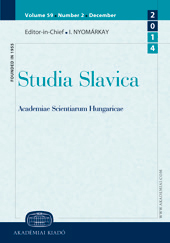Názory Sama Czambela na niektoré fenomény slovensko-maďarských a maďarsko-slovenských jazykových kontaktov
Sam Czambela's views on some phenomena of Slovak-Hungarian and Hungarian-Slovak language contacts
Author(s): Mária ŽilákováSubject(s): Theoretical Linguistics, Lexis, Comparative Linguistics, Finno-Ugrian studies, Western Slavic Languages
Published by: Akadémiai Kiadó
Keywords: Slovak–Hungarian language contacts; bilingualism; terminology; lexicography; regionalism; dialectology;
Summary/Abstract: Samu Czambel established his theoretical knowledge while studying with the most famous contemporary Slavists. He attended O. Asbóth’s lectures at the university in Pest, F. Mikosich’s and V. Jagić’s readings in Vienna, and M. Hattala’s lectures in Prague. After graduating he got work as a legal translator at the Hungarian Ministry of Home Affairs. He became perfectly bilingual and gained a practical attitude during his work that he went deeply into when collecting Slovak dialects in the country. In the center of his interest was to define the place of the Slovak language within the Slavic language group. He considered important to research the Slovak–Hungarian as well as Hungarian–Slovak language contacts, especially the borrowing of words but – while studying phraseology – he also dealt with morphological and syntactic phenomena. He approached the phenomenon of bilingualism in a sensitive way, and he raised several problems when referring to the Middle Slovak language area and Palots dialects. These problems are to be cleared even today. Considering the importance of Slovak– Hungarian and Hungarian–Slovak language contacts, Samu Czambel formulated the need for a relatively big bilingual dictionary.
Journal: Studia Slavica Academiae Scientiarum Hungaricae
- Issue Year: 58/2013
- Issue No: 1
- Page Range: 219-225
- Page Count: 7
- Language: Slovak
- Content File-PDF

